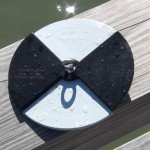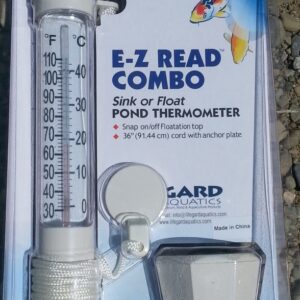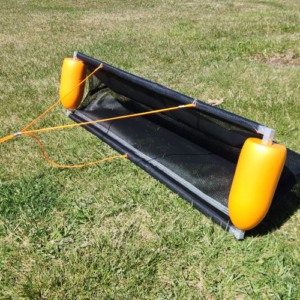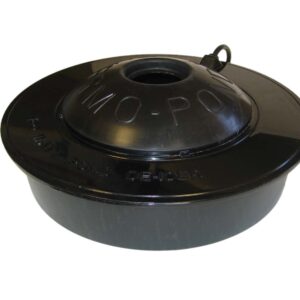The Compact Sechi Disc Designed and Produced by WhatPond .com
The Secchi Disc has been used for many years to monitor water trans parity. From knowing when to do fertilizer treatments to adding beneficial bacteria to clean and clear the water for better visibility.
This is a new design by WhatPond taking into consideration that the metal disc will rust and need painted again and the light weight plastic version where weight is needed to sink the disk. On top of that how can you store an 8″ diameter disc?
We created the new Compact Secchi Disc so it can be folded to look like a bow tie and easier to store. Stainless hardware included. For full details and history of the Secchi Disc, continue below the video or check it out on our You Tube channel.
The Secchi disk originated with Fr. Pietro Angelo Secchi, an astrophysicist, who was requested to measure transparency in the Mediterranean Sea by Commander Cialdi, head of the Papal Navy. Secchi was the scientific adviser to the Pope. Secchi used some white disks to measure the clarity of water in the Mediterranean in April of l865. Various sizes of disks have been used since that time, but the most frequently used disk is an 8 inch diameter metal disk painted in alternate black and white quadrants.
The Secchi disk is used to measure how deep a person can see into the water. It is lowered into the lake by unwinding the waterproof tape to which it is attached and until the observer loses sight of it. The disk is then raised until it reappears. The depth of the water where the disk vanishes and reappears is the Secchi disk reading. The depth level reading on the tape at the surface level of the lake is recorded to the nearest foot.
According to Dr. Lowell Keup, Physical Science Administrator Criteria and Standards, U.S. Environmental Protection Agency, Michigan State University in 1980,” …it is probably the most frequently abused and violated measurement undertaken by limnologists”.
SECCHI DISK READINGS — HOW VALUABLE ARE THEY ?
The greatest value of the Secchi disc measurements occurs when each lake compares its own readings from week to week, month to month and season to season. No comparisons between lakes should be made unless similarities in measurements are followed vigorously. Several factors are involved, such as the eyesight of the viewer, the time of day the readings are taken (midday- between 10 and 2 is preferred), the reflectance of the disc, the color of the water, clay particles or other materials suspended in the water, etc.
Some of the reports for any one season may show an increased water transparency depth after the first week of spring. This may be due to:
Reduced nutrient input from the watershed.
Increased grazing of algae by zooplankton.
Reduced soil erosion into the lake.
Seasonal algae succession.
If the Secchi Disk transparency depths are getting shallower during the summer season, it may be due to one or more of the following:
Increased abundance of free floating algae.
Erosion of the shoreline or erosion from site development near the lake.
Recirculation of bottom sediment from motorboat activity.
Discoloration of the water from wetland runoff and/or plant decomposition.
Increased turbidity.
Reduced zooplankton populations.
Significant storm events within the watershed with the resultant storm water runoff could cause lower Secchi disk readings. Comparing Secchi disc readings immediately after a storm with readings between storms may suggest that runoff is increasing turbidity and, therefore, shallower transparency readings.
If the zooplankton populations have dropped off reducing the grazing of algae, the increase of algae will result in reduced Secchi disk readings. Dr. Robert Carlson, writing in News CLIPs, published by The Citizen Lake Improvement Program of Ohio, “If you find a sharp increase in transparency in May or June, it might be that tiny grazing animals, called zooplankton (‘animal drifters’) are eating the algae. When zooplankton are abundant, they can actually be seen as tiny black dots swimming over the Secchi disk.
SECCHI DATA CONTRIBUTES TO LAKE MANAGEMENT
Oligotrophic — Greater than 16 feet.
Mesotrophic — 6.5 to 16 feet.
Eutrophic — Less than 6.5 feet.
One of the major reasons why Secchi disc measurements decrease from spring to fall, is due to the increase of plankton– both phytoplankton and zooplankton. Since zooplankton graze on phytoplankton, (algae i.e.), the Secchi disc readings may increase during the summer by the reduction of algae in the water. Algae blooms may occur when the amount of available nutrients increases faster than the macrophytes (plants rooted in the bottom of a lake) can absorb them.
SECCHI DISK DATA
Water clarity should be measured with the Secchi Disk once a week from May 1 to September. In order that the Secchi Disk measurement be done to provide the greatest accuracy, the following conditions should be met:
The same person should be taking all readings since sharpness of vision varies from person to person.
The reading should be taken on the same day of the week, or at least not more than one day before or after the same day of the week.
It is preferable that the measurement be taken between 10:00 a.m. and 4:00 p.m. so that the light rays from the sky are at a similar angle each time the reading is taken.
Avoid taking the measurement when the lake is choppy or rough.
The Secchi disk measurement should be taken at the deepest part of the lake. This may be determined by viewing a bathymetric map or using a depth gage.
After anchoring the boat at the predetermined site, take the reading on the shady side of the boat.
The reading should be taken at the same location each week. In order to guarantee a sampling at the same location in the lake, a buoy may be permanently set at the site. If it is not possible to place a buoy at the site, line up two objects on the shore some distance apart (one at the shoreline) and line up two other objects on the shore and at right angles to the plane of the first two, anchor your boat and take the reading. Mark the shoreline objects and the intersect points on your map of the lake so that you will be able to find the same site the following week. If it is necessary that a substitute take the reading later in the season, they will be able to find the same location.
Some lake associations may want to take Secchi measurements at various parts of the lake for clarity comparisons. This may be done, but the measurements should not be part of the monthly report sent into the laboratory.
A Secchi Disk measures water clarity. Water clarity may be affected by three different factors — algae, sediment and / or water color.
Algae may be free floating or rooted on the bottom of lakes. Chara is an example of algae that is rooted on the bottom of lakes and often forms dense beds that rarely reach the surface. Chara may actually out compete other kinds of plants for nutrients, thereby limiting the growth of less desirable aquatic plants.
Free floating algae may be threadlike or ball like and may consist of a single cell or clumped together and visible to the naked eye. The majority, however are microscopic and only visible under a microscope. EPA posters of algae picture many kinds and examples of algae found throughout Michigan. Biology textbooks divide algae into the more common groups of Blue-Green, Green, Golden, Brown and Red.
Algae are very important to a lake ecosystem. Dr. Richard Pippen writes about the value of algae in an article which he wrote for the Michigan Riparian magazine and appeared in the April l978 issue. He states,
“Algae are the most important element and first stage in the so-called food chain. Algae contain the green pigments, chlorophyll, and thus like grasses, garden flowers, and trees, are able to take energy from the sun and make food out of carbon dioxide and water. Small microscopic animals eat algae and in turn are eaten by larger animals which are eaten by still larger animals until they reach the stomachs of fish. Some fish, such as minnows, feed directly upon the algae, thus directly or indirectly the algae serve as a food source for fishes and eventually us.”
Secchi disk readings which show a significant decrease during the summer season and often accompanied by a distinct green, brown or red color are probably due to the proliferation of free floating algae. Only when the populations become exceedingly high or are due to a preponderance of Blue-Green algae should the condition cause alarm. When this happens, the property owners around a lake should determine the sources of nutrient input and take ameliorative action.
Water color data should be recorded at the time the Secchi disk reading is taken. It will help to determine the kind of algae which predominate in the lake at that time.
The most valuable information from Secchi disk data is the graph which shows the weekly changes. Averaging the Secchi disk data for a summer season has very little immediate value. The greatest value of averaging will come when after a period of years the averages will show if the lake’s water quality is remaining constant, improving or degrading.
Definition by the Michigan Lake & Stream Association.





Reviews
There are no reviews yet.